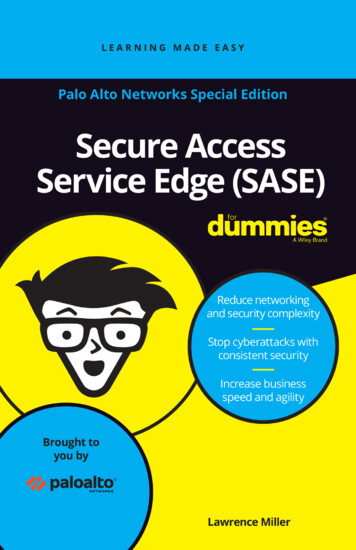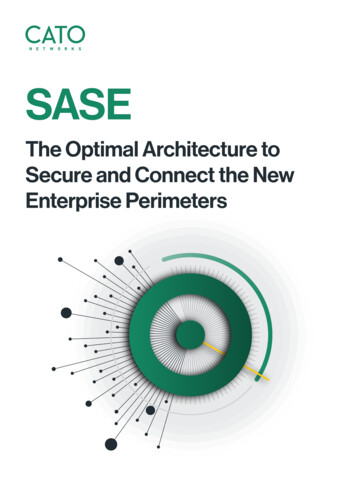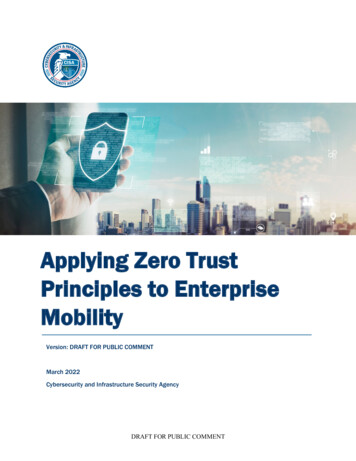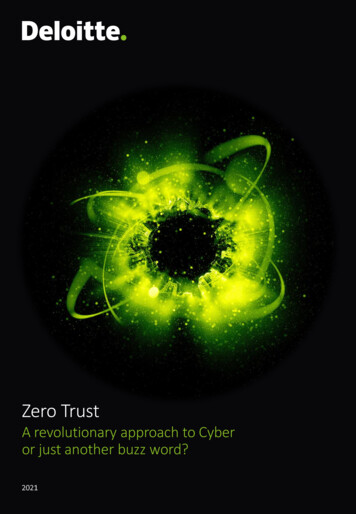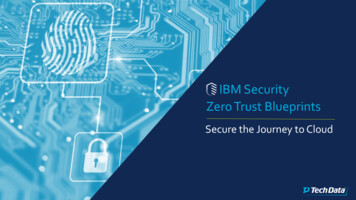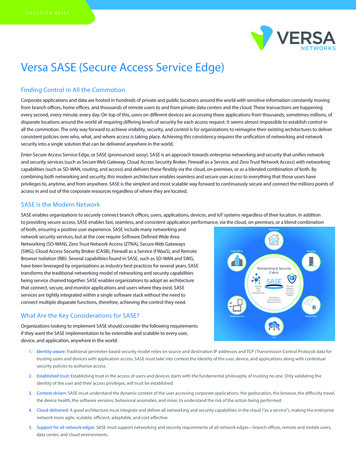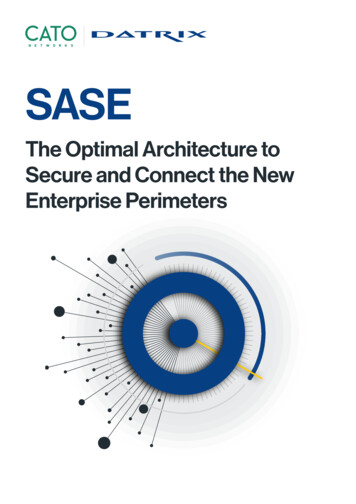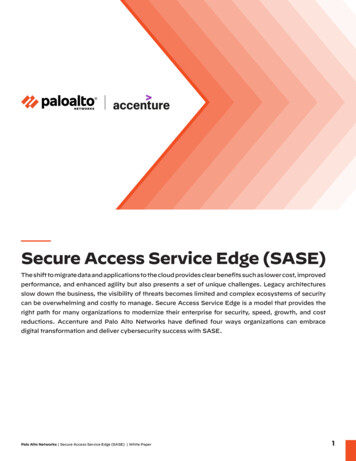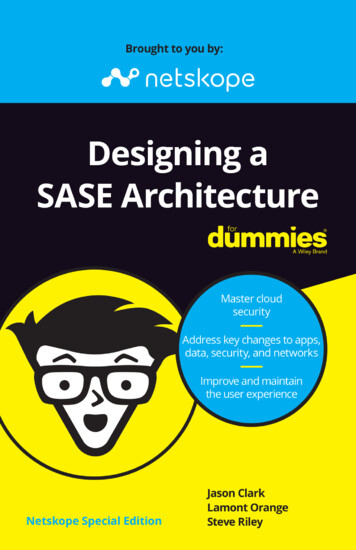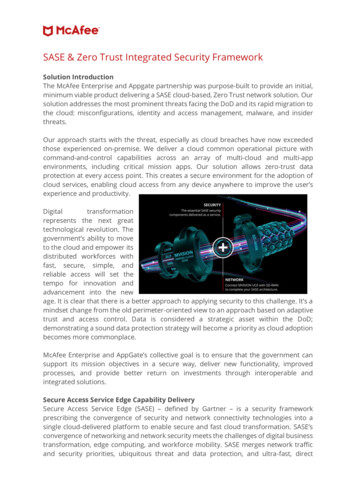
Transcription
SASE & Zero Trust Integrated Security FrameworkSolution IntroductionThe McAfee Enterprise and Appgate partnership was purpose-built to provide an initial,minimum viable product delivering a SASE cloud-based, Zero Trust network solution. Oursolution addresses the most prominent threats facing the DoD and its rapid migration tothe cloud: misconfigurations, identity and access management, malware, and insiderthreats.Our approach starts with the threat, especially as cloud breaches have now exceededthose experienced on-premise. We deliver a cloud common operational picture withcommand-and-control capabilities across an array of multi-cloud and multi-appenvironments, including critical mission apps. Our solution allows zero-trust dataprotection at every access point. This creates a secure environment for the adoption ofcloud services, enabling cloud access from any device anywhere to improve the user’sexperience and productivity.Digitaltransformationrepresents the next greattechnological revolution. Thegovernment’s ability to moveto the cloud and empower itsdistributed workforces withfast, secure, simple, andreliable access will set thetempo for innovation andadvancement into the newage. It is clear that there is a better approach to applying security to this challenge. It’s amindset change from the old perimeter-oriented view to an approach based on adaptivetrust and access control. Data is considered a strategic asset within the DoD;demonstrating a sound data protection strategy will become a priority as cloud adoptionbecomes more commonplace.McAfee Enterprise and AppGate’s collective goal is to ensure that the government cansupport its mission objectives in a secure way, deliver new functionality, improvedprocesses, and provide better return on investments through interoperable andintegrated solutions.Secure Access Service Edge Capability DeliverySecure Access Service Edge (SASE) – defined by Gartner – is a security frameworkprescribing the convergence of security and network connectivity technologies into asingle cloud-delivered platform to enable secure and fast cloud transformation. SASE’sconvergence of networking and network security meets the challenges of digital businesstransformation, edge computing, and workforce mobility. SASE merges network trafficand security priorities, ubiquitous threat and data protection, and ultra-fast, direct
network-to-cloud connectivity. While SASE used to be a matter of sacrificing speed vs.control, our approach has been to integrate Appgate’s ZTNA solution, which is part of theUSAF’s Platform/Cloud One architecture, and McAfee Enterprise’s cloud security solution,which is widely deployed across the Federal government and top-right on Gartner MagicQuadrant. This integrated solution provides both speed to mission and complete controlto protect against the full range of cloud threats, in a zero-trust manner, including:unauthorized access, data spillage/leaks, vulnerable configurations, malware, negligentor malicious insiders and shadow IT. Our recommended framework is designed to allowgovernment enterprise security resources to apply identity and context in order to specifythe exact level of performance, reliability, security, and cost desired for every networksession.The development of our SASE approach was done in large part to improve the efficiencyand security efficacy of a growing mobile workforce. The use of the Internet throughpublic Wi-Fi can become a great security risk. Therefore, accessing DoD applications anddata in a timely, secure manner is a challenge. A SASE framework provides the constructto maintaining higher access speed and performance, while also enabling stringentcontrol of users, data, cloud services, and devices traversing networks – regardless ofwhen, where, and how they’re doing it. SASE represents the best way to achieve a directto-cloud architecture that doesn't compromise on security visibility, control,performance, complexity, or cost. Successful SASE transformation is dependent on thesecurity foundation you start building from.The primary SASE component of our solution is provided by McAfee Enterprise’s MVISIONUnified Cloud Edge (UCE). It represents a first-of-its-kind cloud-native and cloud-deliveredsolution that provides unified data and threat protection from device to cloud, fullyintegrating data loss prevention (DLP), device/user control and other securitytechnologies into web filtering (SWG), endpoint management and cloud control (CASB).UCE provides unified policy management which enables shared data protection policiesand incident management between endpoints, web, and cloud with no increase inoperational overhead.Figure 1: McAfee Enterprise and Appgate's Converged Reference Architecture2
UCE uses common cloud-based management capabilities and systems that shareinformation (e.g., ePolicy Orchestrator – ePO, Data Exchange Layer – DxL) so its decisionsare based on multiple parameters. By enforcing consistent data context and policiesacross endpoints, web, and cloud, UCE protects data as it leaves the device, travels to andfrom the cloud, and within cloud services to create a new secure cloud edge for theenterprise. This unified solution blocks cloud-native breach attempts previously invisibleto the NIPR or SIPR. UCE minimizes inefficient traffic with efficient, intelligent, and securedirect-to-cloud access (network peering) to secure Flow 3 access. Our solution protectsremote sites via SD-WAN integrations utilizing Dynamic IPSec and GRE protocolsleveraging SD-WAN technologies that connect physical sites to cloud resources faster andmore directly. In developing the UCE platform it was vital to deliver a low latency/highscalability platform to secure a global cloud footprint and an expanding DoD cloud-nativearchitecture, including Peering Point of Presence to reduce delays. Reliability is also astrategic benefit of the UCE platform as it delivers 99.999% uptime (maintained serviceavailability) and internet speeds faster than a direct connection will improve theproductivity of the government’s mobile resources.Integrating Customer Edge Security Stacks at the DISN Point of PresenceThe McAfee Enterprise platform provides native security for the customer edge andapplication security layers. Specifically, our platform incorporates native security controlsfor collaboration tools and cloud applications like M365, Teams, OneDrive/SharePoint,and ServiceNOW. The DISN is an MPLS network which defines “who is where” andprovides that level of basic traffic control. The challenge is the DoD is contemplatingextension of the DISN Points of Presence into the cloud while adopting Zero TrustNetwork Access (ZTNA) to enhance security, while not impacting network performance.What is not currently possible is for the government to provide conditional access,tagging, and traffic prioritization/segmentation. In a nutshell, the limitation is the currentinability to segment networks based on conditional access or application rules – SD-WANprovides that capability. Our solution integrates with the Gartner Magic Quadrant SDWAN leaders. The Appgate Software Defined Perimeter (AG SDP) is a ZTNA platform thatintegrates with the UCE platform to enable to DoD to rapidly adapt to how users accessprotected resources and applications. Appgate applies zero-trust conditional-basedaccess policies that are continually monitored and re-evaluated throughout the user’ssession. AG SDP creates a highly-elastic and distributed edge constructed of multiplepolicy enforcement and decision points. This puts security controls as close to the dataas possible and allows users to connect to multiple sites/locations in parallel, with eachuser having one-to-many secure connections. This capability creates a unified securityboundary across any infrastructure; on-premise and cloud, providing the DoD a nextgeneration common operating picture.Traditional network security approaches are failing to adequately protect DoD. Trust ispresumed allowing users to “connect first, authenticate second” and is typically binary innature (access is granted to everything or nothing); meaning, the DoD InformationNetwork (DoDIN) must defend against open listening ports exposed to reconnaissance,denial of service, unauthorized users consuming unauthorized services, inherent overentitlement, and a broad lateral attack surface.3
Integrating Scalable Application Security Stacks in Front of Application WorkloadsUCE was designed to provide protections for SaaS applications such as: Office 365,Teams, OneDrive, ServiceNow, Skype, Workday, DropBox, Adobe, and others. McAfeeEnterprise’s has the largest, most comprehensive SaaS catalog available in the industry.The platform provides a mechanism for expansion for COTS and GOTS applications.We also incorporate ZTNA principals to GOTS applications. We understand that the DoDwill require access to internal-facing, GOTS apps that often contain sensitive information.VPNs (Flow 2) have traditionally been used for this use case, but they suffer fromperformance/scalability constraints and also make it difficult to enforce tight securitycontrols. ZTNA provides fast, direct access to private data center or cloud applicationswhile utilizing granular dynamic access policies that prevent oversharing or lateralmovement.AG SDP employs principles of Zero Trust by taking an Identity and Data Centric approachto security. Users and devices are authenticated before they are allowed to connect.Authorized users must meet access criteria and meet the appropriate conditions beforeand after access is granted. In essence, our integrated platform provides the ICAMcapability, extended visibility to endpoints, as well as a comply-to-connect capability.Figure 2: Appgate SDP's Connection and Authentication WorkflowTo make the DoD’s enterprise edge undiscoverable, AG SDP uses Single PacketAuthorization (SPA) technology, a sophisticated version of port knocking to enforce the“authenticate first, connect second” approach. SPA cloaks infrastructure so that it isinvisible to port scans. It ensures that only authorized users can connect to networkresources. AG SDP’s use of SPA and FIPS-certified mutual TLS have been proven tomitigate man-in-the-middle, denial of service, stolen credentials/access tokens.The UCE platform protects applications (COTS and GOTS) through reverse proxy and/orvia the integration of the application APIs. The government can apply full platformfeatures to these applications. The “integration point” is created from what we call “CASBConnect”. CASB Connect is an innovative, self-serve program which enables any cloudservice provider, customer, or partner to rapidly build lightweight API connectors to the4
UCE platform. CASB Connect API allows users direct access to the SaaS app without anyintermediate proxies and offers DLP (on upload activity), UEBA Activity Monitoring, andCollaboration Control to protect data and address cloud based threats.The CASB component of the UCE platform – MVISION Cloud – considers all applicationsas untrusted and must be authenticated and explicitly authorized to the least privilegerequired in this context it supports the discovery of “Shadow IT”, unapproved applications(security noncompliant applications and infrastructure) being utilized on the networkputting data at risks (e.g., Fire Sharing Services, Cloud-based document processing apps,etc.). This further propagates the application of security at the application layer andensures that proper security is in place to protect the user, the device accessing the SaaSor IaaS app, and the data residing in the app. MVISION Cloud ingests SWG logs andperforms analysis against the logs to identify users accessing cloud-basedPaaS/IaaS/SaaS services. MVISION Cloud then “communicates” back to the SWG to takeaction on what MVISION Cloud determines to be risky. Our solution’s approach enforcesaccess controls on out-of-the-box and custom apps based on contextual parameters suchas user, data, location, activity, and group.Micro-Segmentation and Traffic Flow PrioritizationOur approach leverages a zero trust architecture that is focused on device and cloudpolicy enforcement points and produces unified security operations throughmanagement, threat intelligence sharing, analytics, and orchestration. Integrated withSD-WAN technologies, government application performance will accommodate evolvingrequirements, utilizing unique and adequate network segmentation.The McAfee Enterprise-Appgate solution is purpose-architected to take an agnosticapproach to SD-WAN integration. We will integrate the SD-WAN with the SWG faction ofthe UCE platform to address challenges that the government has in moving itsapplications and data to the cloud environment. Integration with SD-WAN enables bettersupport for both hybrid (Flow 2) and direct-access cloud (Flow 3) customers, specificallysimplifying a sprawling set of remote sites and greater mobility among resources. Ourapproach provides a simple, performant, reliable way to achieve security for internetbreakout and private WAN elimination.With SD-WAN providing segmentation for both the network and application layers forcomprehensive inbound and outbound protection. When integrating UCE, AG SDP, andSD-WAN, the government will benefit from a power toolset which prevents intellectualproperty and sensitive data exfiltration, regulatory compliance, and forensic dataavailability in the event of an incident.McAfee Enterprise, in particular, has certified interoperability with six (6) of the industry’sleading SD-WAN providers (Silver Peak (HPE), Versa Networks, Viptela (Cisco), VeloCloud(VMWare), and Citrix). By bringing together UCE, AG SDP, and SD-WAN in a seamlesslyintegrated solution, the government can deliver SASE and build a network securityarchitecture fit for its digital transformation and rapid cloud adoption. Security isaddressed by AG SDP’s access control and through UCE’s threat, data, and cloud5
application protection capabilities, as well as the distributed firewall capabilities deliveredby SD-WAN. Through a single, fast internet connection, SD-WAN intelligently andefficiently routes traffic directly to cloud resources or back to the on-premiseenvironment. With UCE and SDP providing security directly in the cloud, SD-WAN willforward web- and cloud-bound traffic directly, without any excessive latency. Cost savingsare realized from removing expensive MPLS lines, and since the majority of traffic nolonger needs to backhaul through the data center/on-premise environment, additionalsavings can be achieved by reducing central network bandwidth and infrastructurecapacity.Integrating with Capabilities at IL4/5 and Preparing for IL6McAfee Enterprise’s platform currently integrates, out-of-the-box, with existinggovernment capabilities at NIPR (IL4-5), including: M365, Teams, GovCloud, MilCloud,ServiceNOW, Adobe, and others. No matter which SaaS applications the governmentwishes to consume on the DISN, the McAfee Enterprise platform can address it. Ourplatform provides the “last mile” to connect an untrusted network (through Appgate), tothe endpoint, and to IL4/5 capabilities. The McAfee Enterprise tenant currently resides inGovCloud. As our cloud boundary (CASB) achieves IL5 this summer we will continue towork with DISA RME to achieve IL6 certification for our cloud boundary that will operatein the AWS Secret Region. Appgate is currently deployed as a Customer Edge SecurityStack for the USAF’s IL5 environment. This capability is also being leveraged to replacelegacy VPN across Air Force bases and is being referred to as the Zero Trust NetworkAccess Point (ZTAP). ZTAP has been targeted by USAF to be implemented in their IL6environment and is currently in prototype.We provide integrations with IaaS, PaaS, SaaS capabilities. Currently, the government’sfocal point for IL6 is on the IaaS/PaaS environments. As SaaS capabilities achieveoperations at IL6 we are preparing to provide data and threat protection in a zero trustmatter for those applications.Figure 3: Gartner's definition of SASE and the Network Security component mapping to McAfeeEnterprise’s UCE Platform6
Considerations for SASE/ZT s/ConsiderationsSolution enables a data centric approach to resource authorization; consuming metadata tags/labels for policy alignmentSolution must provide a unified policy enforcement & decision point that leveragesICAM attributes, device posture telemetry for Comply-to-Connect, meta-data tags/labels,and additional context derived from other security or mission toolsProvide a government-authorized alternative to the Cloud Access Point. Solution mustprovide the ability to connect users to cloud and on-premise resources with adistributed and elastic perimeterSolution must provide multi-vector data protection, including: Blocking upload ofsensitive docs; block or limit access to risky sites and enforce tenant restrictions; providein-tenant scans to prevent malware and data loss; prevent file uploads and emails tounauthorized sites or parties; prevent copy to cloud personal apps USB, print, screencapture; enable email of sensitive files to internal recipient and not to unapproved 3 rdparties; enable transfer of sensitive files to internal recipient and prevent sharing tounapproved 3rd parties.Operate at 99.999% uptimeSolution must provide threat protection controls that adapt to changes in risk andcontext.The solution must deliver complete visibility and control over data at every policydecision point regardless of whether it’s at the endpoint, through the web, or in thecloud.Provides a security approach for both cloud-native application threats (e.g., Teams,M365) as well as providing protection from cloud misconfigurations.We recommend that the government’s solution leverage one or many identity sources(e.g., distributed or federated) to authenticate users and natively support multipleauthentication, including PKI, to continuously challenge the “least privileged” ZT caveat.We recommend that the government further consider, clarify, and define ingress,egress, and network services categories of ZTNA. Ingress SASE should be considered asprivate access where IP, PII, and mission-critical data are housed and prioritized. EgressSASE secures access to the internet and internet-based SaaS applications. Egress SASE iswhere SWG and CASB components of the SASE architecture are incorporated to secureaccess to internet and SaaS apps. Lastly, the network layer is solved for by SD-WAN.We recommend that the government consider incorporating behavioral analytics anddata loss prevention factors when considering its ZT/SASE architecture.The solution should deliver a micro-segmented software defined perimeter that is ableto control North/South and East/West flows between the user and its applications.Due to the expanse of the current DoD DevOps pipeline, the solution should be built tointegrate into CI/CD pipelines to deliver security as code.We also recommend that the government consider re-aligning its definition of SASEaccording to the Gartner definition. Please see Figure 2 below for additional information.The solution should provide support for micro-segmentation within cloud nativeapplications in support of containers.
The McAfee Enterprise and Appgate partnership was purpose-built to provide an initial, minimum viable product delivering a SASE cloud-based, Zero Trust network solution. Our solution addresses the most prominent threats facing the DoD and its rapid migration to the cloud: misconfigurations, identity and access management, malware, and insider
